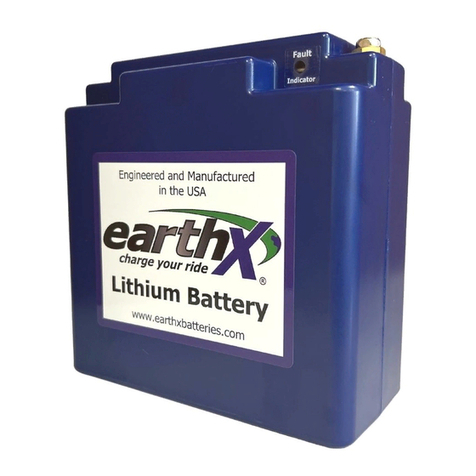is >13.3V). Lead-acid batteries are made with 6 cells in series. Another difference is that
lithium cells are a dry cell technology, where the cells are packaged individually. As such, the
individual cell’s charge level will diverge with repeated charge/discharge cycles and age. This
condition reduces the performance of the battery (reduces capacity), for the battery charge
level is only as good as the charge level of the weakest cell. Moreover, charging a battery
with unbalanced cells results in one or more cells reaching the maximum charge (voltage)
level before the rest of the cells in the series, which leads to over-charging of the cell(s) and
eventual failure.
ETZ - BMS
All EarthX integrated BMSs continuously monitor each cell’s voltage as part of the cell
balancing and over-charge protection. If the voltage of a cell exceeds the others, the BMS
circuits will work to reduce that cell’s charge level. This ensures that the charge level of all
the cells remains equal, even with the high discharge (> 100Amps) and charge current
(>10Amps) of your vehicle.
A cell can be permanently damaged if over-charged (over-voltage) just one time. The BMS
has circuitry to disconnect the battery from the charging system (plug-in charger or your
vehicle) if the voltage exceeds 15.5 volts (an over-charge condition). The ETX Hundred
Series batteries have enhanced over-charge protection; see the ETX - Hundred Series section
below for more details.
The ETZ BMS has short circuit protection, but it is not resettable or repairable.
ETX - BMS
The ETX series BMS has all the features of the ETZ series, plus over-discharged protection
(completely draining the battery), excessive cranking protection, and short-circuit protection.
The BMS disconnects the battery from the load if it is drained to less than 5% remaining
charge (an over-discharge condition). An over-discharged battery typically has a voltage less
than 11.5V. If the BMS disconnects the battery, the voltage reading of the battery will be
zero volts. Excessive cranking protection logic includes temperature monitoring to limit
“high current use” (engine cranking) to 10 -30 seconds in any 60 second period. If the
battery terminals are “shorted” (or a low impedance load is connected across terminals),
which causes the battery volts to instantaneously drop to a very low level, the battery will
disconnect from the load to protect the cells and BMS from damage (short circuit
protection). If the BMS disconnects due to excessive cranking protection or short circuit
protection, the BMS will automatically reconnect after a cooldown period (typically 1-3
minutes). The ETX series is designed for short circuit protection > 1000 Amps.
ETX Hundred Series - BMS
The ETX “Hundred Series” was specifically designed for the experimental aircraft market
(models include the ETX680C, ETX680, ETX900, ETX900-VNT, ETX1200). Only the
ETX “Hundred Series” battery models are recommended for use as the primary aircraft
battery (starter battery). In addition to the features found in the ETZ and ETX series
motorsports batteries, critical electronic circuits are redundant, the over-charge protection is






























